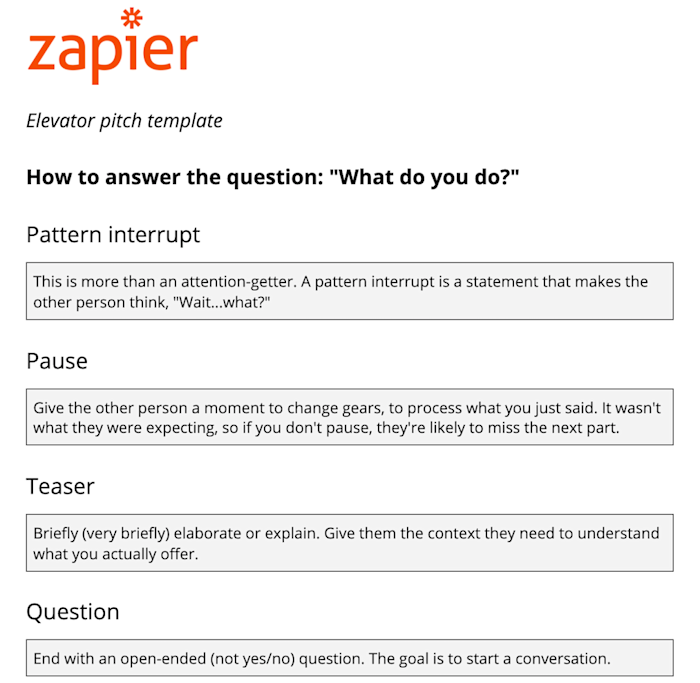The elevator pitch might seem like an outdated idea—something an intern in a ’90s comedy had to come up with for a big presentation. But with increasingly short attention spans, the immediacy of social media, and the vast quantity of information bombarding people on an hourly basis, the concept of a short, attention-getting pitch is still valid.
And that’s really the key to an effective elevator pitch: short and catchy.
What is an elevator pitch?
Meant for a quick answer to a question like “What do you do?” or “What does your company do?” the elevator pitch is a short description of your shtick, about one to three sentences long.
It’s called an elevator pitch because, back in the day, when people wore suits and rode elevators together without fearing for their lives, they’d have an elevator ride’s worth of time to give their pitch.
How to write an elevator pitch
Your elevator pitch should begin with something unexpected (so people keep listening) and end with a question (so people engage).
I’m a business navigation consultant—I help entrepreneurs overcome their fear of failure to get to where they want to be. But that’s not my elevator pitch. This is:
I help people and organizations turn fiction into autobiography [pause for a second]. Most of us are living an unfinished story and would like to end up in an amazing place. What’s that place for you, and do you know how to get there?
The point is to surprise the listener a bit with a “pattern interrupt.”
They’re expecting to hear “I’m an attorney” or “I own XYZ Company” or “we sell coffee,” but instead, they’re caught a little off guard, they begin to pay attention, and they think, “wait…what?” The pause in the middle gives them time to process and change gears, starting to actually listen with interest.
Then I provide a little more context, so they realize I’m not talking about writing an actual book. And finally, I hit them with a question that requires a response other than just “yes” or “no.” This isn’t a mindless question, nor is it particularly easy to answer. Rather, it begins a conversation about them. Asking a probing question builds rapport—it shows that you’re not just trying to sell them something (even if ultimately you do want them to buy from you).
Just be careful: it can be difficult to do this without sounding trite. Make sure your question is genuine and unique—not something they’ve heard a million times.
How to deliver and hone an elevator pitch
When delivering an elevator pitch in person (or at least live), you need to be sure your delivery lives up to the pitch.
Practice it. Then, once you’ve practiced for a while, practice more. You want it to become second nature (but not sound rehearsed, which, ironically, comes with rehearsing).
You also need to test it out. Implement it as you meet new people, and check your results. If the pitch isn’t leading to more and deeper conversations, go back to the drawing board. And don’t be afraid to ask people what they thought about your elevator pitch (just don’t call it that when you’re talking to them). Feedback like this can be exactly what you need to make it work.
Keep refining until you get something that consistently works for you.
Adapt your pitch to the medium
This method is meant for live elevator pitches. Of course, if you’re delivering your elevator pitch in writing, you won’t be able to have that pause or ask that same kind of conversational follow-up question.
I recommend creating a few versions of your pitch depending on the medium and the audience. For example, it’ll be different depending on whether you’re introducing yourself to a potential client on a sales call versus introducing yourself to multiple people at once in a Facebook Group.
But regardless of the audience and regardless of the medium, those two original rules still stand: start with a hook and end with a question.
Elevator pitch template
Here’s an elevator pitch template to follow.

Now go out and sell yourself
—
Guest Author: ERIC BESCHINSKI—ZAPIER
This article first appeared in www.fastcompany.com
Seeking to build and grow your brand using the force of consumer insight, strategic foresight, creative disruption and technology prowess? Talk to us at +971 50 6254340 or engage@groupisd.com or visit www.groupisd.com/story

